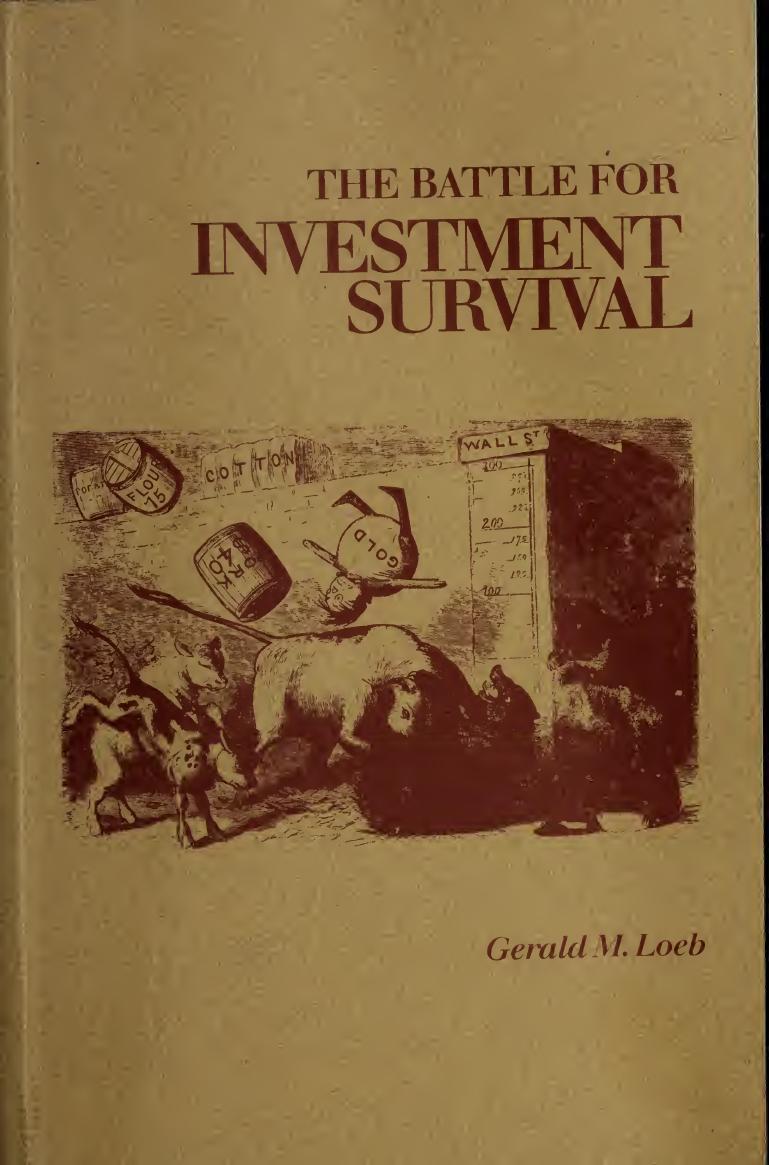The Battle for Investment Survival by Gerald M. Loeb

Author:Gerald M. Loeb
Language: eng
Format: epub, pdf
Tags: Investments & Securities - General, Finance, Investments, Speculation, Stock exchanges, Stocks, Investments & Securities - Stocks, Business / Economics / Finance, Business/Economics
Publisher: Fraser Pub. Co.
fashion in 1937. At that time, people bought Nickel to hedge against war and to hedge against inflation and because it could be sold in several different markets for Canadian dollars or pounds or francs. This over-enthusiasm resulted in bidding the stock up to a terrific premium. (2) Earnings declined. During the war years, the government dictated prices and of course taxes were higher. (3) The dividends declined. (4) In 1937, Nickel in the enthusiasm of that day, sold at 22 times earnings and to yield about 3*A%. In 1952 it sold at a price earnings ratio of about 10 times earnings and to yield 6 l A%. In other words, even though earnings and dividends were higher in 1952 than they were in 1937, Nickel sold lower, partly because of the elimination of the over-enthusiasm for the shares and partly because earnings in general sold for less in 1952 than they did in 1937 and higher yields were demanded.
The record shows how losses can occur even in solid issues with a growth trend, if timing is bad and excessive premiums are paid for popularity.
An investor in N.Y. Central in 1929 suffered from almost every conceivable cause of market losses. (1) The market and hence N.Y. Central was over-valued. In the 1929-32 decline the market and Central went from over to under-valuation. (2) The railroads lost markets to other transportation. (3) Population gains in the east started to fall to a slower pace than in west and south. (4) Earnings collapsed. (5) Dividends were passed. The record shows how costly bad timing could be and the rallies from 9 to 55 and 7 to 36 illustrate that even in a stock where the long pull tide has been out, great percentage gains can be made by correct timing.
Prior to 1929 New York Central was considered a premier blue chip investment stock with a safe dividend.
Technicolor is a good example of how romance can be overdone. In 1930, when the stock sold at 86V4, it represented little more than a tremendous capitalization of the idea of color movies. It sold at 61 times its 1930 earnings. A calculation at the time, based on Technicolor capturing 10098 of the film mar-
Download
The Battle for Investment Survival by Gerald M. Loeb.pdf
This site does not store any files on its server. We only index and link to content provided by other sites. Please contact the content providers to delete copyright contents if any and email us, we'll remove relevant links or contents immediately.
| Analysis & Strategy | Bonds |
| Commodities | Derivatives |
| Futures | Introduction |
| Mutual Funds | Online Trading |
| Options | Portfolio Management |
| Real Estate | Stocks |
Pioneering Portfolio Management by David F. Swensen(5606)
Rich Dad Poor Dad by Robert T. Kiyosaki(5149)
How To Win Friends and Influence People by Dale Carnegie(3771)
The Money Culture by Michael Lewis(3284)
The Dhandho Investor by Mohnish Pabrai(3168)
The Wisdom of Finance by Mihir Desai(3079)
Liar's Poker by Michael Lewis(2812)
The Intelligent Investor by Benjamin Graham Jason Zweig(2596)
The ONE Thing by Gary Keller(2519)
Mastering Bitcoin: Programming the Open Blockchain by Andreas M. Antonopoulos(2511)
Investing For Dummies by Eric Tyson(2470)
How to Day Trade for a Living: Tools, Tactics, Money Management, Discipline and Trading Psychology by Andrew Aziz(2445)
How to Win Friends and Influence People by Dale Carnegie(2435)
Rich Dad Poor Dad: What The Rich Teach Their Kids About Money - That The Poor And Middle Class Do Not! by Robert T. Kiyosaki(2434)
Fooled by Randomness: The Hidden Role of Chance in Life and in the Markets by Nassim Nicholas Taleb(2413)
Zero Hour by Harry S. Dent Jr. & Andrew Pancholi(2246)
Market Wizards by Jack D. Schwager(2163)
Rich Dad's Guide to Investing by Robert T. Kiyosaki(2111)
How to Pay Zero Taxes, 2018 by Jeff A. Schnepper(2100)
